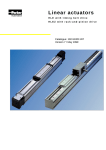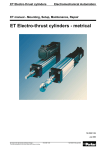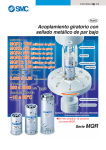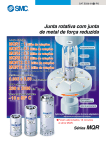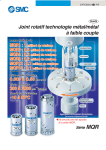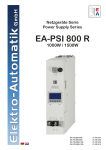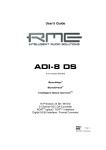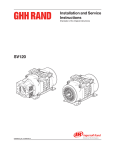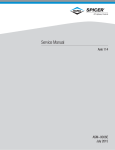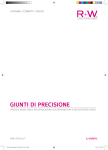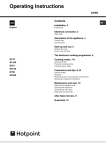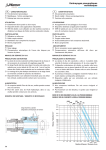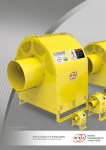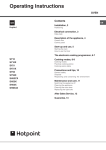Download LCB User Manual - Parkermotion.com
Transcript
LCB Compact Linear Actuator Electromechanical Automation LCB Manual - Installation, Commissioning, Maintenance and Repair LCB Compact Linear Actuator 192-510014 N03 July 2006 Sizes LCB040 and LCB060 Twe reserve the right to make technical changes. The data correspond to the current status at the time of printing. 25.07.06 09:02 192-510014 N03 July 2006 Introduction LCB Compact Linear Actuator ____________________________ EME - Electromechanical Automation Europe C E R T I F I E D DIN EN ISO 9001 Q U Parker Hannifin GmbH&Co.KG Electromechanical Automation P O Box: 77607-1720 Robert-Bosch-Str. 22 D-77656 Offenburg Tel.: +49 (0)781 509-0 Fax: +49 (0)781 509-98176 A M Germany: L I T T Y S Y S Reg. Nr. 36 38 E-Mail: [email protected] mailto:[email protected] Internet: www.parker-eme.com http://www.parker-eme.com England: Parker Hannifin plc Electromechanical Automation Arena Business Centre Holy Rood Close Poole, Dorset BH17 7BA UK Tel.: +44 (0)1202606300 Fax: +44 (0)1202 606301 E-mail: [email protected] mailto:[email protected] Internet: www.parker-eme.com http://www.parker-eme.com Italy: Parker Hannifin S. p. A Electromechanical Automation Via Gounod 1 I-20092 Cinisello Balsamo (MI), Italy Tel.: +39 (0)266012459 Fax: +39 (0)2660 12808 E-mail: [email protected] mailto:[email protected] Internet: www.parker-eme.com http://www.parker-eme.com 2 192-510014 N03 July 2006 E Parker EME Introduction 1. Introduction In this chapter you can read about: Device assignment.................................................................................................................................. 3 1.1 Device assignment This manual applies to the following devices: Linear actuator: LCB040 Linear actuator: LCB060 192-510014 N03 July 2006 3 Introduction LCB Compact Linear Actuator Contents 1. Introduction ................................................................................................3 1.1 Device assignment .................................................................................. 3 2. Safety Instructions ....................................................................................6 2.1 Intended use............................................................................................. 6 2.2 Identifying Residual Dangers and Hazardous Areas ............................ 6 2.3 General hazards on Non-compliance..................................................... 6 2.4 Working safely ......................................................................................... 7 2.4.1. Heed the Instructions............................................................................................................................7 2.4.2. Operating personnel. ............................................................................................................................7 2.5 Safety Instructions for the Company Using the System ...................... 7 2.6 Safety Instructions for Operating Personnel......................................... 7 2.7 Instructions for Special Hazards ............................................................ 8 2.8 User Conversions and Changes are Not Permitted .............................. 8 2.9 Transport .................................................................................................. 8 2.9.1. Product description ..............................................................................................................................9 3. LCB040 & LCB060 ...................................................................................10 3.1 Product design....................................................................................... 11 3.2 Mechanical data ..................................................................................... 12 3.3 3.2.1. Dimensional drawings LCB040 & LCB060.......................................................................................12 3.2.2. Dimensional drawings of drive options ...........................................................................................14 3.2.3. Dimensions dual-axis actuator..........................................................................................................15 Technical data ........................................................................................ 16 3.3.1. Load diagrams / wear..........................................................................................................................17 3.3.2. Required drive torque .........................................................................................................................21 3.3.3. Location of mass barycenter or point of force application ...........................................................21 3.3.4. Critical whirling speed of the dual-axis actuator connection shaft .............................................22 4. Set-Up........................................................................................................23 4 4.1 Preparations for substructure .............................................................. 23 4.2 Fitting / mouting..................................................................................... 25 4.2.1. Installation of a single actuator.........................................................................................................25 4.2.2. Installation of a double-axis actuator ...............................................................................................26 4.2.3. End limits..............................................................................................................................................27 4.2.4. Attachment of Motor or Gearbox ......................................................................................................27 192-510014 N03 July 2006 Parker EME Introduction 5. Maintenance and service ........................................................................28 5.1 Safety Instruction................................................................................... 28 5.2 Maintenance schedule........................................................................... 29 5.3 Check free movement of the sliding carriage...................................... 29 5.4 Replacment interval for wearing parts................................................. 29 5.5 Checking / exchanging /tensioning timing belt................................... 31 5.5.1. Dismantling the timing belt................................................................................................................32 5.5.2. Insert new timing belt .........................................................................................................................32 6. Spare and Wearing Parts ........................................................................34 6.1 Sliding block........................................................................................... 34 6.2 Toothed belt ........................................................................................... 34 7. Accessories..............................................................................................35 7.1 External buffers...................................................................................... 35 7.2 Electrical limit switches ........................................................................ 36 7.3 Clamping profiles................................................................................... 37 7.4 T-Nuts and bolts..................................................................................... 38 8. Accessories order code ..........................................................................39 8.1 Order code for the LCB basic unit........................................................ 41 8.2 Order code for the LCB coupling kit .................................................... 42 8.3 Order code for intermediate drive shaft for LCB (for dual-axis actuator) ................................................................................................. 43 9. Index..........................................................................................................44 192-510014 N03 July 2006 5 Safety Instructions LCB Compact Linear Actuator 2. Safety Instructions 2.1 Intended use The LCB linear actuator has a number of uses including: Positioning, transporting, feeding, removing, pallet handling, loading, unloading, processing and manipulating workpieces or tools. Since the LCB can be used in a very wide range of applications, the user is responsible for its use in specific applications. The user must ensure that mounting workpieces or tools on the sliding carriage of the linear actuator does not cause danger of injury to persons and/or damage to property. This also applies, for example, to the case of a broken timing belt. The linear actuator must only be used in areas that are not accessible to persons during operation. If the linear actuator is used in areas accessible to people, it must be installed in such a manner that no one can be endangered during operation. 2.2 Identifying Residual Dangers and Hazardous Areas If there are still residual dangers present to persons or property from the linear actuator in spite of operating it in a safe manner, the user must make reference to these residual dangers through signs and written rules requiring appropriate procedures. The following safety signal words are used: 2.3 Danger Indicates that an imminent hazardous situation may lead to death or serious bodily harm if not prevented using appropriate safety measures. Warning Indicates a potentially hazardous situation which, if not avoided using appropriate safety measures, could result in serious or minor injury. Caution Indicates a potentially hazardous situation which, if not avoided using appropriate safety measures, may result in minor injury or damage. Hint Provides important information about the product, how to handle the product or about the part of the manual to which particular attention must be paid. General hazards on Non-compliance This machine component has been designed in accordance with state-of-the-art technical developments and is operationally reliable. If it is not operated by qualified or at least trained personnel or if it is operated improperly or not in accordance with the operating instructions, however, the unit may bear the risk of hazards. ♦ The following danger may occur: ♦ Physical danger and threat to the life of the user or other parties ♦ Detriment to the machine and the property of the user If the linear motor module is installed in a machine, the safety requirements noted in the operating instructions for that machine must be combined with those described in this manual. 6 192-510014 N03 July 2006 Parker EME Safety Instructions 2.4 Working safely 2.4.1. Heed the Instructions The information (such as instructions and notes) contained in the commissioning instructions must be heeded for all work involved in installing, commissioning, setting up, operating, changing operating conditions and modes, servicing, inspecting and repairing the unit. 2.4.2. Operating personnel. The following jobs must only be performed by appropriately trained and authorised personnel: ♦ Installation and set-up tasks on the linear motor module ♦ Attaching safety transmitter switches (initiators) ♦ Connecting the drive and testing the travel direction 2.5 Safety Instructions for the Company Using the System Supervisors must also become familiar with the entire chapter entitled "Safety" and handling required on the linear motor module. Supervisors must ensure that installation and operating personnel have read and understand the chapter entitled "Safety" and the description of how to work with the machine, and that they observe the instructions. The linear motor module must always be in flawless condition during operation. 2.6 Safety Instructions for Operating Personnel Any work step that has a negative effect on the operating safety of the linear motor module must be omitted. Operating and supervisory personnel are required to check the linear motor module or machine at least once per shift for externally visible damage or defects. Changes that have occurred (including the operating behaviour) that could have a negative effect on the operating safety must be reported immediately. Components and accessories are designed especially for this product. When purchasing spare and wearing parts, use only original Parker parts. We note here explicitly that we are unable to check or release spare parts or accessories that were not provided by us. Installing and/or using such products may cause negative changes in the required design properties in some circumstances, which in turn could negatively effect the active and/or passive operating safety of the product. The manufacturer is unable to accept any liability for damage caused by using non-original parts and accessories. Safety and protection devices are strictly NOT to be removed or bypassed or set out of order. Applicable requirements and national accident prevention regulations must always be observed when installing and operating our linear motor module. 192-510014 N03 July 2006 7 Safety Instructions 2.7 LCB Compact Linear Actuator Instructions for Special Hazards The LCB must be fastened or supported at the required minimum distances according to information provided in this manual. The operator must ensure that movements of the LCB do not cause any danger. If the LCB moves in hazardous areas, these areas can be safeguarded with safety transmitter switches. 2.8 User Conversions and Changes are Not Permitted The linear actuator must not be changed in its design or in terms of safety without our approval. Any change as defined here made by the user excludes any liability on our part. 2.9 Transport Danger Never step under overhead loads – danger of being injured! Moving parts – especially the sliding carriage* of the linear actuator – must always be secured against slipping or moving. *By wrapping several turns of strong adhesive tape around the sliding carriage, which if possible is in the centre of the profile, for example. Hint Danger when transporting long actuators. Because the actuator bends under its own weight, guiding accuracy may deteriorate significantly. In addition, the shape of the profile may change and the travel behaviour of the sliding carriage may be negatively affected. In general no means of transport are needed for the LCB. The linear actuator can be carried, depending on the size, by one or two persons. 8 192-510014 N03 July 2006 Parker EME 2.9.1. Safety Instructions Product description Features ♦ Available in 2 sizes ♦ LCB040 ♦ LCB060 ♦ Maximum thrust force ♦ 160N (LCB040) ♦ 560N (LCB060) ♦ Typical payload ♦ 1kg - 6kg (LCB040) ♦ 1kg - 30kg (LCB060) ♦ Maximum static bearing capacity in normal direction: ♦ 1,250N (LCB040) ♦ 3,850N (LCB060) ♦ Maximum stroke ♦ 2m (LCB040) ♦ 5.5m (LCB060) ♦ Velocity up to 8m/s 2 ♦ Acceleration up to 20m/s ♦ Repeatability: ±0.2mm Typical areas of application ♦ Pick-&-Place applications ♦ Packaging, labelling and wrapping systems ♦ Sensor and format adjustment (e.g. back-stop) ♦ Pusher-, picker- and gripper applications ♦ Positioning ♦ Feeding ♦ Cutting 192-510014 N03 July 2006 9 LCB040 & LCB060 LCB Compact Linear Actuator 3. LCB040 & LCB060 In this chapter you can read about: Product design ...................................................................................................................................... 11 Mechanical data.................................................................................................................................... 12 Technical data....................................................................................................................................... 16 LCB040 LCB060 M1:1 (protection of utility patents: 20 2004 014 821.8) 10 192-510014 N03 July 2006 Parker EME 3.1 LCB040 & LCB060 Product design The LCB is protected by registered design No. 20 2004 014 821.8 20 2004 014 821.8 Guide (1) / sliding carriage (2): ♦ The external sliding guide is incorporated as part of the aluminium profile. It is unnecessary to adjust two separate guiding rails. ♦ The sliding carriage is available in three lengths. With a longer sliding carriage there is greater distance between the sliding blocks (3) and this improves the load capacity with respect to yawing and pitching moments. ♦ Maintenance-free sliding guiding with integrated dry-film lubricant. ♦ Sliding carriage (3) can be easily changed within 2 minutes without detensioning the timing belt. ♦ The timing belt of LCB40 is tensioned directly at the sliding carriage by means of spacer plates (4). On the LCB060, the timing belt is tensioned via tensioning screws at the tensioning station (5). ♦ The low moving mass allows highly-dynamic movement to be achieved and saves operating power. Profile (6): ♦ Available in 2 sizes ♦ High resistance to flexing ♦ High torsional stiffness due to the closed profile ♦ Compact design, minimum installation space required ♦ Dirt tolerant, chemically and mechanically robust Timing belt drive (7): Drive (8): ♦ High stiffness and accuracy provided by the generously-dimensioned timing belt. ♦ Drive options: ♦ Linear actuator with free shaft end ♦ Coupling (9) & gearbox ♦ Coupling, gearbox and motor (stepper or servo) ♦ Coupling, gearbox, motor and controller ♦ Coupling and direct-drive motor (10) with Compax3. 192-510014 N03 July 2006 11 40 40 Drive station SR 6xM5, 8 deep 0.6x45° 0.6x45° Long carriage L 200 170 60 40 40 Drive station BL/BR 10xM5, 8 deep Medium carriage M 150 120 60 Profile length = Length of carriage + Stroke + 14mm 0.6x45° 36 It is not possible to attach the LCB inside this area 48 73 10xM5, 8 deep 2 x M5, 9 deep X 40 ± 0.2 47.5 (width of guiding) 73 Detail X (enlarged) Dimensional drawings LCB040 & LCB060 Drive station SL 100 60 A It is not possible to attach the LCB inside this area 60* Short carriage S 35 (see below) Length of carriage 3.2.1. 0.6x45° 2 5+0.3 1x45° 6.7 6 Detail Y (enlarged) 8.5 4.8 73 46.75 Y 13 Stroke 40 60 Section A-A 73 Total length = Length of carriage + stroke + 146 40 60 73 40 60 73 A Ø8 m6 8 30 47,5 Necessary space for changing the plastic sliders Ø8 m6 192-510014 N03 July 2006 30 33.5 12 73 Definition: Right/left Mechanical data Ø8m6 3.2 Ø8 m6 LCB040 & LCB060 LCB Compact Linear Actuator LCB040 Basic unit dimensions 3D CAD-Data http://www.parker.com/ead/cm2.asp?cmid=10008 60 ± 0.25 30 A 4xM6, 10 deep 4xM5, 10 deep 70 70 Drive station SR 6xM6, 10 deep 0.6x45° 150 100 80 60 Short carriage S 0.6x45° 20 10.25 2.5 Drive station SL 21 8+0.3 71.5 7.2 10.5 8+0.3 Detail X (Enlarged 40 44 48 Timing belt tensioning screws It is not possible to attach the LCB inside this area 60 X 80 60 70 Long carriage L 4xM6, 10 deep 80 60 6xM6, 10 deep 70 0.6x45° 60 ± 0.2 120 83 (width of guiding) 4xM5, 10 deep 4xM6, 10 deep M6 (2x) Ø5H7 (2x) 250 200 55 114 4xM5, 10 deep Drive station BL/BR 0.6x45° 200 150 80 60 Medium carriage M It is not possible to attach the LCB inside this area 40 A 100 Length of carriage 60 12 44 Total length = Length of carriage + Stroke + 228 Stroke 120 90 ± 0.25 Definition: Right/left 6xM6, 10 deep 40 114 120 Ø15h8 100 Ø15h8 60 10.25 2.5 Ø15h8 44 Ø15h8 44 44 100 83 120 10 45.5 120 192-510014 N03 July 2006 44 Parker EME LCB040 & LCB060 LCB060 Basic unit dimensions 3D CAD-Data http://www.parker.com/ead/cm2.asp?cmid=10008 13 LCB040 & LCB060 3.2.2. LCB Compact Linear Actuator Dimensional drawings of drive options LCB drive options L, M Drive option L Drive option M LCB040 prepared for planetary gearbox PTN060 LCB060 prepared for planetary gearbox PTN080 Ø20H7 Passfeder / key DIN 6885-A-5x5 4x Ø6,6 40 LCB060 60 Ø14H7 Ø60 +0,2 4 x Ø5,5 4 15 LCB040 95 3 4 15,5 23 Passfeder / key DIN 6885-A-6x6 Ø 70 Ø 80 Ø40 +0,2 +0,1 Ø52 60 60 LCB drive options U, W Drive option U Drive option W LCB040 prepared for servo motor SMH60 (direct drive) only for single actuators with horizontal installation position LCB060 prepared for servo motor SMH100 (direct drive) only for single actuators with horizontal installation position 4 x M5 LCB040 3 4,5 4 15,5 40 Ø19 H7 Ø95 +0,2 60 Ø9 H7 38,5 LCB060 4 13,5 93,5 Ø40 +0,2 +0,1 60 Ø63 4x M8 Passfeder / key DIN 6885-A-6x6 100 Ø 115 LCB drive options N, P Drive option N Drive option P LCB040 prepared for stepper motor SY56 (direct drive) only for single actuators with horizontal installation position LCB060 prepared for stepper motor SY107 (direct drive) only for single actuators with horizontal installation position 14 192-510014 N03 July 2006 Parker EME 3.2.3. LCB040 & LCB060 Dimensions dual-axis actuator Dimensions dual-axis actuator LCB060 Achsabstand / distance + 120 8 35 Achsabstand AA / distance AA Ø20 Ø30 Ø15 Achsabstand / distance + 73 Achsabstand AA / distance AA 35 14 8 192-510014 N03 July 2006 66 Ø40 LCB040 66 14 15 LCB040 & LCB060 3.3 LCB Compact Linear Actuator Technical data Technical data issued 05/2005, using safety factor S=1. The technical data applies under standard conditions and only for the individually specified operating mode and load. In the case of compound loads, it is necessary to verify in accordance with normal physical laws and technical standards whether individual ratings should to be reduced. In case of doubt please contact Parker Hannifin. Travel length and speed LCB - Size Maximum travel speed Maximum acceleration Maximum stroke Units LCB040 LCB060 m/s 2 m/s mm 5 20 2000 8 20 5500 Torques, forces, dimensions of pulley and timing belt LCB - Size Units LCB040 LCB060 Travel distance per revolution Diameter of pulley Timing belt width / pitch Weight of timing belt Maximum drive torque Static load capacity in normal direction Maximum thrust force (effective load) Repeatability mm/rev mm mm kg/m Nm N N mm 125 39.79 16 / 5 0.048 3.2 1250 160 ± 0.2 170 54.11 25 / 10 0.167 15.2 3850 560 ± 0.2 Units LCB040 LCB060 kg kg kg kg 1.47 1.66 1.85 0.39 4.33 4.71 5.10 1.41 kg 0.46 1.53 kg kg/m 0.53 2.45 1.66 5.21 2 2.44 14.83 2 2.72 15.80 2 3.00 16.72 2 kgcm 0.01 0.06 2 (kgcm )/m 0.37 5 Units LCB040 LCB060 mm mm mm mm x mm 4 cm 4 cm 246 296 346 40 x 60 x 73 17.93 17.79 378 428 478 60 x 90 x120 92.9 109.3 Weight and mass moments of inertia LCB - Size Weight of base unit with zero stroke LCB with short sliding carriage LCB with medium sliding carriage LCB with long sliding carriage Weight of moved mass with short sliding carriage Weight of moved mass with medium sliding carriage Weight of moved mass with long sliding carriage Additional weight per metre of stroke Mass moment of inertia relative to the drive shaft LCB with free shaft, short sliding carriage, 1m of stroke LCB with free shaft, medium sliding carriage, 1m of stroke LCB with free shaft, long sliding carriage, 1m of stroke Mass moment of inertia of coupling Additional mass moment of inertia due to the weight of the timing belt per metre of stroke kgcm kgcm kgcm Overall dimensions & physical data LCB - Size Length with short sliding carriage, zero stroke Length with medium sliding carriage, zero stroke Length with long sliding carriage, zero stroke Cross-section (height x width x profile width) Moment of inertia Ix Moment of inertia Iy 4 Moment of inertia It E-modulus (aluminium) cm 2 N/mm 35.68 202.2 5 0.72x10 Temperature data -20°C to +60°C The nominal data are valid for ambient temperatures between +15°C and +30°C. Temperature range 16 192-510014 N03 July 2006 Parker EME 3.3.1. LCB040 & LCB060 Load diagrams / wear Requirements: The diagrams are valid solely for the guiding and under ideal operating conditions, faultless guidings provided. The diagrams are based on a trapezoidal motion sequence with 3 identically long sections for acceleration, constant travel and deceleration. The diagrams are normalized on defined payloads: LCB040 with 1 kgs, LCB060 with 5 kgs. Shown are the respective mass centroids with their typical load arms. Lifetime: Naturally, the sliding guiding has already a slight play under new condition, so that the guiding does not jam and the sliding carriage moves smoothly. The play is measured as a gap for each slide and is approx. 0.1 to 0.2mm in normal direction and at the sides. During the operation, the play increases according to the loads shown in the diagrams. If a certain state of wear is reached, at the lastest however at the wear limit (0.5mm for the LCB040, 1.0mm for the LCB060), the slides can be exchanged easily within a few minutes. After the exchange, a new liftime cycle begins according to the diagrams. Use of the diagrams: The diagrams can be interpolated with respect to lifetime and extrapolated with respect to load. (for example: halfed operational performance results in halfed wear, doubled load will result in halfed mileage in km). LCB040 – Lifetime / slides 20 40 18 30 Laufleistung / Travel [1000km] Laufleistung / Travel [1000km] 35 M L 25 S 20 15 10 S=100mm 5 5 10 15 Beschleunigung / Acceleration [m/s²] 20 8 S 6 S=100mm 4 0 L=200mm 5 10 15 Beschleunigung / Acceleration [m/s²] 20 6 Laufleistung / Travel [1000km] Laufleistung / Travel [1000km] 10 2 5 L M 4 S 3 2 S=100mm 5 4 L M 3 S 2 S=100mm 1 M=150mm L=200mm 0 M 12 M=150mm 6 1 14 M=150mm L=200mm 0 L 16 5 10 15 Beschleunigung / Acceleration [m/s²] M=150mm L=200mm 20 192-510014 N03 July 2006 0 5 10 15 Beschleunigung / Acceleration [m/s²] 20 17 LCB040 & LCB060 LCB Compact Linear Actuator 7 7 L 6 Laufleistung / Travel [1000km] Laufleistung / Travel [1000km] 6 M 5 S 4 3 2 S=100mm 1 S 5 4 3 2 S=100mm M=150mm 1 M=150mm L=200mm L=200mm 0 5 10 15 20 0 Beschleunigung / Acceleration [m/s²] 7 L M 20 S 5 4 3 2 S=100mm 1 L 6 Laufleistung / Travel [1000km] Laufleistung / Travel [1000km] 5 10 15 Beschleunigung / Acceleration [m/s²] 7 6 M 5 4 S 3 2 S=100mm 1 M=150mm M=150mm L=200mm 0 L M 5 10 15 Beschleunigung / Acceleration [m/s²] L=200mm 20 0 5 10 15 20 Beschleunigung / Acceleration [m/s²] 18 30 16 Laufleistung / Travel [1000km] Laufleistung / Travel [1000km] 25 L 20 M 15 10 S S=100mm 5 18 5 10 15 Beschleunigung / Acceleration [m/s²] L 12 10 M 8 6 S 4 M=150mm S=100mm M=150mm 2 L=200mm 0 14 20 192-510014 N03 July 2006 0 L=200mm 5 10 15 Beschleunigung / Acceleration [m/s²] 20 Parker EME LCB040 & LCB060 LCB060 – Lifetime / slides 80 35 30 Laufleistung / Travel [1000km] Laufleistung / Travel [1000km] 70 60 50 S M L 40 30 20 S=150mm 10 25 L M 20 S 15 10 S=150mm 5 M=200mm M=200mm L=250mm 0 5 10 15 Beschleunigung / Acceleration [m/s²] L=250mm 20 0 5 10 15 Beschleunigung / Acceleration [m/s²] 20 8 12 L 7 Laufleistung / Travel [1000km] Laufleistung / Travel [1000km] 10 L 8 S M 6 4 S=150mm 2 6 M S 5 4 3 2 S=150mm 1 M=200mm M=200mm L=250mm 0 5 10 15 Beschleunigung / Acceleration [m/s²] L=250mm 20 Laufleistung / Travel [1000km] Laufleistung / Travel [1000km] 8 S 6 4 0 20 10 L M 2 5 10 15 Beschleunigung / Acceleration [m/s²] 12 12 10 0 S=150mm L M 8 S 6 4 2 S=150mm M=200mm M=200mm L=250mm L=250mm 5 10 15 Beschleunigung / Acceleration [m/s²] 20 192-510014 N03 July 2006 0 5 10 15 Beschleunigung / Acceleration [m/s²] 20 19 LCB040 & LCB060 LCB Compact Linear Actuator 12 12 10 L Laufleistung / Travel [1000km] Laufleistung / Travel [1000km] 10 M 8 S 6 4 S=150mm 2 0 L M 8 S 6 4 S=150mm 2 M=200mm M=200mm L=250mm L=250mm 5 10 15 Beschleunigung / Acceleration [m/s²] 0 20 35 5 10 15 Beschleunigung / Acceleration [m/s²] 20 25 30 20 Laufleistung / Travel [1000km] Laufleistung / Travel [1000km] L 25 15 15 M 20 S S=150mm S 5 M=200mm 20 5 10 15 Beschleunigung / Acceleration [m/s²] S=150mm M=200mm L=250mm 0 M 10 10 5 L L=250mm 20 192-510014 N03 July 2006 0 5 10 15 Beschleunigung / Acceleration [m/s²] 20 Parker EME 3.3.2. LCB040 & LCB060 Required drive torque The diagrams include both acceleration and friction forces! LCB040 – required drive torque Horizontal mounting position 3,2 (1) a (2) a (3) a (4) a (5) a (6) a (7) a (8) a Antriebsmoment / Driving torque [Nm] 2,8 2,4 2,0 vertical mounting position (upward acceleration) 3,2 = 0m/s2 = 1m/s2 = 2m/s2 = 3m/s2 = 5m/s2 = 7m/s2 = 10m/s2 = 20m/s2 (1) a = 0m/s2 (2) a = 1m/s2 (3) a = 2m/s2 (4) a = 3m/s2 (5) a = 5m/s2 (6) a = 7m/s2 (7) a = 10m/s2 (8) a = 20m/s2 (8) 2,8 2,4 (7) 2,0 (8) (7) (6) (5) (4) (3) (2) (6) (1) 1,6 1,6 (5) (4) (3) (2) 1,2 0,8 1,2 0,8 (1) 0,4 0,4 0,0 0 1 2 3 4 5 6 0,0 0 1 2 3 4 5 6 Nutzlast / Payload [ kg] Nutzlast / Payload [ kg] (1): Constant movement (8): Acceleration LCB060 – required drive torque Horizontal mounting position 14,0 (1) a = 0m/s2 (2) a = 1m/s2 (3) a = 2m/s2 (4) a = 3m/s2 (5) a = 5m/s2 (6) a = 7m/s2 (7) a = 10m/s2 (8) a = 20m/s2 12,0 Antriebsmoment / Driving torque [Nm] vertical mounting position (upward acceleration) 10,0 14,0 (1) a = 0m/s2 (2) a = 1m/s2 (3) a = 2m/s2 12,0 (4) a = 3m/s2 (5) a = 5m/s2 (6) a = 7m/s2 10,0 (7) a = 10m/s2 (8) a = 20m/s2 (8) (7) (6) 8,0 (7) (6) (5) (4) (3) (2) (1) 8,0 (5) (4) 6,0 (8) (3) 6,0 (2) 4,0 4,0 (1) 2,0 0,0 2,0 0 5 10 15 20 25 30 0,0 0 5 10 Nutzlast / Payload [ kg] 15 20 25 30 Nutzlast / Payload [ kg] (1): Constant movement (8): Acceleration 3.3.3. Location of mass barycenter or point of force application 2:1 rule Displayed at the example of the pitching moment, is also valid for rolling and yawing moments respectively CoG F ! lL = Load lever lT = Support lever lL lL < 2 x lT lT 192-510014 N03 July 2006 21 LCB040 & LCB060 3.3.4. LCB Compact Linear Actuator Critical whirling speed of the dual-axis actuator connection shaft The critical whirling speed is the speed from which the connection shaft of the double-axis actuator shows natural oscillation. This oscillation can get so strong that, in an extreme case, the double-axis connection is destroyed. The critical whirling speed depends on the length of the connection shaft (=linear to the axis distance) and on the speed of the shaft (=linear to the speed of the actuator). The diagrams show from where it is necessary to equip the connection shaft with an additional support in the middle of the shaft. LCB040 Achsabstand / distance [mm] 1000 900 (2) 800 (1) 700 600 500 0,0 1,0 2,0 3,0 4,0 5,0 6,0 Geschwindigkeit / speed [m/s] 7,0 8,0 (1) Connection shaft without intermediate shaft bearing (2) Connection shaft must be supported LCB060 1500 (3) Achsabstand / distance [mm] 1400 (2) 1300 1200 (1) 1100 1000 900 0,0 1,0 2,0 3,0 4,0 5,0 Geschwindigkeit / speed [m/s] (1) Connection shaft without intermediate shaft bearing (2) Connection shaft must be supported (3) impermissible range 22 192-510014 N03 July 2006 6,0 7,0 8,0 Parker EME Set-Up 4. Set-Up In this chapter you can read about: Preparations for substructure ............................................................................................................... 23 Fitting / mouting..................................................................................................................................... 25 4.1 Preparations for substructure Each holding point must be even with a flat parallelism of 0.2 mm. All holding points must be aligned with parallelism to each other of better than 0.5 mm. To simplify installation and adjustment, the holding points for the linear actuator can also consist of adapter plates. They can be aligned with tightening and pressure screws. Deflection vs. distance between mountings and payload Fn Fn SA SA 192-510014 N03 July 2006 SA 23 Set-Up LCB Compact Linear Actuator LCB040 10000,0 Kraft / Force Fn [N] 1000,0 100,0 (1) 10,0 1,0 1,0 mm 0,5 mm 0,3 mm 0,2 mm 0,1 mm 0,1 0 500 1000 1500 2000 2500 3000 Stützabstand / Distance between mountings SA [mm] (1): Max. permissible deflection LCB060 10000,0 Kraft / Force Fn [N] 1000,0 100,0 (1) 10,0 1,0 1500 2000 2500 3000 Stützabstand / Distance between mountings SA [mm] (1): Max. permissible deflection 24 192-510014 N03 July 2006 2,00 mm 1000 1,00 mm 500 0,50 mm 0 0,30 mm 0,20 mm 0,1 3500 4000 Parker EME Set-Up 4.2 Fitting / mouting 4.2.1. Installation of a single actuator Danger when transporting long actuators. Because the actuator bends under its own weight, guiding accuracy may deteriorate significantly. In addition, the shape of the profile may change Caution and the travel behaviour of the sliding carriage may be negatively affected. Additional information on transport: (see on page 8) Hint When fitting the LCB into your plant, please make sure that the deflection station and the sliding carriage are accessible for maintenance! (Provide enough space behind the deflection station so that the sliding blocks or the sliding carriage can be removed). ♦ Take the linear actuator out of the shipping crate. ♦ Place the LCB on the connection points, which have been previously levelled (water level, levelling device). ♦ Fasten the actuator in place. (mounting possibilities for LCB (see on page 25)) ♦ Fasten the connection parts in place. Hint There are two ways to fasten the LCB in place. ♦ Mounting with clamping profiles or With T slot bolts/nuts that are guided into the grooves of the aluminium profile. Type Designation LCB040 T-Nut LCB040 T-Nut LCB040 Square nuts* DIN 562-M4 LCB040 Square nuts* DIN 562-M5 LCB040 Hexagon nut* DIN 934-M4 LCB040 Hexagon nut* DIN 934-M5 LCB060 T-bolt DIN787 M8x8x25 LCB060 T-bolt DIN787 M8x8x32 LCB060 T-bolt DIN787 M8x8x40 LCB060 T-Nut LCB060 T-Nut LCB060 T-Nut LCB060 T-Nut * Square and hexagon nuts should only be used for D E M4 8 M5 8 M4 7 M5 8 M4 7 M5 8 M8 13 M8 13 M8 13 M4 13.7 M5 13.7 M6 13.8 M8 13.8 lightly-loaded I1 K GA 11.5 4 4 11.5 4 4 -2.2 --2.7 --2.9 --3.7 -13 6 -13 6 -13 6 -22 7 7.5 22 7 7.5 23 7.3 5.5 23 7.3 7.5 attachments L ------25 32 40 ----- Art. No. 127-004020 127-004021 135-700001 135-700003 135-700600 135-700700 131-700001 131-700002 131-700003 127-006015 127-006016 400-000033 400-000034 The standard installation position is horizontal with the sliding carriage up. Hint Optionally (after consultation with the manufacturer) a horizontal installation position with the sliding carriage on the side or at the bottom or vertical installation are also possible. 192-510014 N03 July 2006 25 Set-Up 4.2.2. LCB Compact Linear Actuator Installation of a double-axis actuator ♦ Take the linear actuator out of the shipping crate. ♦ Place the LCB on the connection points, which have been previously levelled (water level, levelling device). ♦ Fix the module (mounting possibilities for LCB (see on page 25)) ♦ Place second actuator and fix slightly. ♦ Measuring the parallelism (measure tape). ♦ Measure both diagonals in order to verify rectangularity (measuring tape). Correct diagonal measure by parallel movement of the second linear actuator, if necessary. ♦ Verify the horizontal alignment of the linear actuators (water level, levelling device) and correct if needs be. ♦ Fix the second actuator permanently. ♦ If the sliding carriages of the two linear actuators are to be linked mechanically, please take care that the system is mounted nondistortedly with respect to the guiding and the drive train. In order to avoid torsional stress, loosen and refasten the couplings of the shaft kit if needs be. Alignment of a double-axis actuator (1) Axis distance (2) Measure to profile end = (1) = = (2) = Installation of a shaft kit A LK P LK MA ♦ The sliding carriages of the two linear actuators must stand on the same position P (Recommendation: push both actuators to the same stop). ♦ Place half-coupling for small shaft diameter on the free shaft ends with distance A und tighten clamping screw with torque MA. Insert plastic part. ♦ Slide the two other coupling halves on to the connection shaft. ♦ Position connection shaft between the free shaft ends and push the respective coupling halves towards each other. Caution! Do not push to block – coupling package must have total length LK. ♦ Tighten clamping screws on both coupling halves on the connection shaft with torque MA. LCB040 26 A Distance coupling / drive station MA LK LCB060 Units 8 14 Tightening torque of clamping screws 1.4 10.5 Nm Length of coupling package 35 66 mm 192-510014 N03 July 2006 mm Parker EME 4.2.3. Set-Up End limits The software end limits (programmable end limits) can be used to define the maximum travel path in the positive and negative direction. The machine zero initiator (home switch) must always be within the software end limits. The switch must be mounted so that the sliding carriage can under no circumstances travel beyond (the switch should ideally be mounted in proximity of the drive station or the deflection station. switching distance 2 – 4 mm) if needs be an additional external buffer must be fitted. 4.2.4. Caution The software end limits are not preset. For this reason, they must be defined and entered into the control system before the unit is placed in service. Hint Recommendation: the actual zero point of your controller should be the same as the machine zero point. Attachment of Motor or Gearbox If you ordered the LCB together with a coupling kit, the coupling housing with the half-coupling is already mounted on the drive shaft of the linear actuator. In this case please proceed with step 2, if not start with step 1. (1) If the coupling housing and the half-coupling are not pre-assembled, please proceed as follows: ♦ Place half-coupling for small shaft diameter on the drive shaft (with distance AL to LCB) and tighten clamping screw with torque MA. ♦ Insert plastic part. ♦ Mount coupling housing (2) Coupling housing and half coupling are pre-assembled: ♦ Place the other half-coupling on the gear- or motor shaft and fix with distance AK to the flange surface of the drive unit with torque MA. ♦ Fix gearbox and motor to the coupling housing (the gearbox shaft must be exactly centrical with respect to the drive shaft of the linear actuator! ♦ There should be only an air gap of about 0.5-1mm between the half-coupling on the gearbox- or motor shaft and the other half-coupling. (1) AK ca. 1 AL Drawing without lateral cover LCB040 L Drive option (PTN060) AK Distance between flange surface of the coupling housing and the coupling MA Tightening torque of clamping screws AL Distance between flange surface of the coupling housing and the drive station 23 LCB060 Units U (SMH60) N (SY56) M (PTN080) W (SMH100) P (SY107) 4.5 40 15 13.5 54 mm 1.4 10.5 Nm 8 14 mm Dimensional drawing drive options (see on page 14) 192-510014 N03 July 2006 27 Maintenance and service LCB Compact Linear Actuator 5. Maintenance and service In this chapter you can read about: Safety Instruction .................................................................................................................................. 28 Maintenance schedule.......................................................................................................................... 29 Check free movement of the sliding carriage....................................................................................... 29 Replacment interval for wearing parts.................................................................................................. 29 Checking / exchanging /tensioning timing belt..................................................................................... 31 Use only repair parts of Parker Hannifin GmbH & Co.KG. Improper or unprofessional repair will lead to an expiry of any warranty. If you encounter problems, please contact: Parker Hannifin GmbH & Co KG Electromechanical Automation Service Dept. Tel.: (+49) (0)781 509-700 Fax: (+49) (0)781 509-98316 5.1 Safety Instruction Before performing any maintenance or repair work, turn the power switch to the '0' setting and secure it with a padlock against manipulation. If the unit needs to be operable for specific repair works, you have to be especially cautious: Ensure by all means that no persons are in the hazardous area. If required, safeguard the hazardous area with additional barriers or gratings against unauthorised persons. Repair jobs must only be performed by qualified specialists or employees of Parker. Only qualified expert personnel is permitted to perform works on the linear actuator. All the applicable regulations and provisions must be heeded (IEC, EN, national accident prevention regulations etc.). Qualified persons as the term is used in this manual are persons who: ♦ Persons who, by virtue to their training, experience and instruction, and their knowledge of pertinent norms, specifications, accident prevention regulations and operational relationships, have been authorised by the person responsible for the safety of the system to perform the required task and are capable of recognising potential hazards and avoiding them (definition of technical personnel according to VDE015 or IEC364), ♦ Persons who have a knowledge of first-aid techniques and the local emergency rescue services. ♦ Persons who have read and will observe the safety instructions. If set-up, repair or maintenance works require that safety installations be dismounted, these must be reinstalled immediately after the respective works have been completed. The unit must be shut down before any of the safety installations are dismounted. 28 192-510014 N03 July 2006 Parker EME 5.2 Maintenance and service Maintenance schedule Hint Please take special care during all maintenance and repair that the guiding surface remains intact! WHEN WHAT ACTION After commissioning Sliding carriage Check free movement of the sliding carriage by manually moving the sliding carriage. (Check) (see on page 29) every 4 weeks or every 1000km* Sliding carriage Semi-annually or every 5,000km Check sliding carriage play and replace sliding blocks if necessary. (exchange wearing parts) (see on page 29) Check free movement of the sliding carriage by manually moving the sliding carriage. (Check) (see on page 29) Visual inspection of the timing belt for wear. Change timing Toothed belt belt if necessary. (Check timing belt) (see on page 31) *With the very first set of sliding blocks (new LCB) please check the sliding carriage play weekly or every two weeks, as an increased wear can be expected during the initial break-in phase. 5.3 Check free movement of the sliding carriage Move the sliding carriage manually over the entire stroke distance after assembly or setup. The sliding carriage must move easily and with constant force. If the sliding carriage does not move easily or rather "joltily", please check the following: ♦ Make a visual inspection of the guiding. Check for visual wear and for smoothness of the guiding surface. If necessary, replace profile. If the force needed to move the sliding carriage changes continually (increases or decreases continually), an alignment error of the double-axis actuator could be the case. Realign double axis actuator (see on page 26). ♦ Possibly too high deflection of the guiding profile If needs be, reduce distance between supports (see on page 23). ♦ If the causes mentioned above do not apply, please check the sliding carriage play (check sliding play) (see on page 29). 5.4 Replacment interval for wearing parts Check sliding carriage / play of sliding carriage The diagrams "load-bearing capacity of sliding carriage / wear" (see on page 17) show the wear of the slides under ideal load conditions. The wear can differ from the indicated curves in a specific application. Depending on the load and the distance traveled, the sliding blocks in the sliding carriage wear down and the sliding carriage play will increase accordingly. If the increased sliding carriage play does not have a negative influence on the application, the sliding blocks can be operated up to the wear limit (0.5mm wear for LCB040 and 1.0mm wear for LCB060). The wear limit given in the diagrams may under no circumstances be exceeded – this could damage the surface of the guiding irreversibly! Check sliding play (LCB) Use a feeler gauge stock to determine the current wear as shown in the photograph on the left. Lift sliding carriage plate for measurement. 192-510014 N03 July 2006 29 Maintenance and service LCB Compact Linear Actuator Exchange sliding block (LCB) The sliding block is a wearing part. You need 4 pieces per linear actuator . LCB040: Order-No.: 127-004016 LCB060: Order-No.: 127-006014 We recommend to have at least 4 sliding blocks on stock. We recommend to drive or to push the sliding carriage to the deflection station for changing the sliding blocks. Remove/mount covers: Unscrew only the two upper screws of the cover at the deflection station (unscrew for about 1 – 3mm, not more as they do not only fix the cover but also the deflection station itself). Remove cover in upwards direction Unscrew the two fixing screws at all four sliding blocks entirely and remove sliding blocks. Mount new sliding blocks in reverse order. Tighten screws only slightly. Move sliding carriage forwards and backwards several times (so that the sliding blocks are aligned) and then tighten screws. Check sliding carriage again for free movement. 30 192-510014 N03 July 2006 Parker EME 5.5 Maintenance and service Checking / exchanging / tensioning timing belt Visual inspection of the timing belt A sign of wear may have different causes so that it is not always possible, to determine the exact cause. The following table shows possible causes for typical damages: Problem mögliche Ursache Action Abnormal wear of loaded tooth flanks of the belt Faulty belt pre-tension Exchange timing belt, set pre-tension. Overload Exchange timing belt, set pre-tension. Check, if the load is in the admissible range. Abnormal wear at the tooth root surface of th belt Abnormal wear at the side flank of the belt Sheared off belt teeth Pre-tension too high Exchange timing belt, set pre-tension. Drive torque too high Verify drive dimensioning. Faulty alignment of timing belt Exchange timing belt, set pre-tension. Twisted edge of the roller/pulley Please contact us. Pre-tensioning too weak Exchange timing belt, set pre-tension. Overload (by collision) Splits at the belt teeth Faulty belt pre-tension Exchange timing belt, set pre-tension. Overload Exchange timing belt, set pre-tension. Check, if the load is in the admissible range. Breaking of the timing belt Deterioration of the belt material Exchange timing belt, set pre-tension. Faulty belt pre-tension Exchange timing belt, set pre-tension. Overload Exchange timing belt, set pre-tension. Check, if the load is in the admissible range. Softening of the timing belt material Operating temperature too high Exchange timing belt, set pre-tension. Lower operating temperature. Contact with solvent Exchange timing belt, set pre-tension. Do not clean belt with solvents. Skipping of teeth, loss of machine zero Pre-tension too low Set pre-tension correctly. Wrong motor position (below) with vertical application If possible move drive upwards Alternatively: Increase pre-tension or reduce load in lengthwise direction. 192-510014 N03 July 2006 31 Maintenance and service 5.5.1. LCB Compact Linear Actuator Dismantling the timing belt We recommend to remove the covers at the drive station and the deflection station before dismantling the timing belt (easy access) Remove cover plates (see on page 30)). ♦ Unscrew tensioning bracket on both sides of the sliding carriage and remove from support in the sliding carriage plate. (Caution! Make sure not to loose the small distance plate of the LCB040! Unless you can no longer set the original belt tension!) ♦ Push timing belt sidewards out of the clamping bracket. 5.5.2. Insert new timing belt ♦ Remove old timing belt (dismountig (see on page 32 ) and mount new belt. ♦ The new timing belt must have exactly the same length and pitch as the old timing belt! ♦ In the case of a long axis it may be helpful to connect the new belt to the old one (e.g. with tape) in order to insert the new belt while removing the old one. ♦ Insert ends of belt cautiously into both clamping brackets . ♦ On the LCB040, first screw the clamping bracket to the sliding carriage on the side of the drive station (as the timing belt of the LCB040 is tensioned on the other side of the sliding carriage). LCB040 Tension belt ♦ On the LCB040, first screw the clamping bracket to the sliding carriage on the side of the drive station (as the timing belt of the LCB040 is tensioned on the other side of the sliding carriage). ♦ Fix the clamping bracket on the opposite side of the sliding carriage (side towards the deflection station) and place the original small distance distance plates. The belt has now its originally preset tension. ♦ If you dispose of a belt tension measuring device (see on page 33), you may use this to tension the belt to a value of 220N. LCB060 Tension belt 32 ♦ The belt of a LCB060 must be tensioned to a value of 760N. ♦ Please use a suitable belt tension measuring device RMS (see on page 33) for measuring and setting this value. 192-510014 N03 July 2006 Parker EME Maintenance and service Belt tension measuring device RSM The RSM belt tension measuring device determines the tension of the belt on the basis of preset data (specific mass of belt, freely oscillating length of belt) and the oscillating frequency of the belt. The belt tension measuring device can be purchased at Parker (Part No. 037-000200). An operating manual with a description of the measuring procedure comes with the device. (1) (2) (1) timing belt tensioning screws (2) counter screws ♦ The belt is tensioned with the aid of the timing belt tensioning screws at the tensioning station (loosen lock nut during tensioning process and re-fasten afterwards) ♦ After tensioning, the belt must be aligned. ♦ An exact alignment is only possible during movement of the sliding carriage, with correct adjustment the timing belt always oscillates from left to right (in the driving direction). ♦ In order to keep the pre-tension of the belt, please turn the tensioning screws only in very small steps. ♦ If necessary, check belt tension again after the alignment. 192-510014 N03 July 2006 33 Spare and Wearing Parts LCB Compact Linear Actuator 6. Spare and Wearing Parts 1: Sliding block 2: Toothed belt 6.1 Sliding block The sliding block is a wearing part. You need 4 pieces per linear actuator . LCB040: Order-No.: 127-004016 LCB060: Order-No.: 127-006014 We recommend to have at least 4 sliding blocks on stock. 6.2 Timing belt Type Designation LCB040 Timing belt LCB060 Timing belt desired length L1 L2 L1 : Length of sliding carriage L2 : Length of profile 34 Art. No. L1 : Length of carriage or L2 : Length of profile must be 420-000004 stated L1 : Length of carriage or L2 : Length of profile must be 420-000016 stated 192-510014 N03 July 2006 Parker EME Accessories 7. Accessories In this chapter you can read about: External buffers ..................................................................................................................................... 35 Electrical limit switches ......................................................................................................................... 36 Clamping profiles .................................................................................................................................. 37 T-Nuts and bolts.................................................................................................................................... 38 7.1 External buffers (1) (1) We recommend to mount always two external buffers per side. Type Designation Art. No. Art. No. stainless LCB040 LCB060 Buffer module Buffer module 510-001445 510-001645 510-001495 510-001695 192-510014 N03 July 2006 35 Accessories 7.2 LCB Compact Linear Actuator Electrical limit switches LCB040 60 51 1 4,5 10 6 5 7 26 12 40 4,5 LCB060 6 20 69 80 5,5 12 5 5 25 26 35 4,5 40 Connection diagram LCB040 and LCB060 1: PNP normally closed contact 2 -3: Load br 1 bn sw A 2 bk bl 3 bu Technical data: limit switches LCB040 and LCB060 Switching distance 2mm / 4mm ± 10% Switch hysteresis > 1% ...< 15% Repeatability 0.01mm Temperature drift < 10% Ambient temperature -25°C - +70°C Protection class IP67 Cable length 6m Type LCB040 LCB040 LCB040 LCB040 LCB060 LCB060 LCB060 LCB060 36 Electrical characteristics Rated Voltage Voltage range Supply current Maximum load current Residual voltage Max. switching frequency Connecting cables 24VDC 10...35VDC < 15mA 300mA < 2,5VDC 2 kHz Designation Electrical limit switch NPN normally closed contact with 6m cable and fixing material Electrical limit switch NPN normally open contact with 6m cable and fixing material Electrical limit switch PNP normally closed contact with 6m cable and fixing material Electrical limit switch PNP normally open contact with 6m cable and fixing material Electrical limit switch NPN normally closed contact with 6m cable and fixing material Electrical limit switch NPN normally open contact with 6m cable and fixing material Electrical limit switch PNP normally closed contact with 6m cable and fixing material Electrical limit switch PNP normally open contact with 6m cable and fixing material 192-510014 N03 July 2006 2 3 x 0.25mm Art. No. 510-001435 510-001436 510-001437 510-001438 510-001635 510-001636 510-001637 510-001638 Parker EME 7.3 Accessories Clamping profiles The toe clamps are used in conjunction with the standard load attachment plate to rapidly install and attach various combinations of linear actuators. Two clamping profiles are needed to fix a LCB on a flange plate. (The clamping profiles may not be used in the range of the drive- or of the clamping station). LCB040 Order-No.: 500-000910 53 40 12 Ø10 16,5 20 6,5 6 9,9-02 Ø5,5 LCB060 Order-No.: 500-000901 20 7 Ø11 Ø15 15 Ø6,6 Ø9 9 30 20 10 60 ±0,2 Order-No.: 500000905 90 192-510014 N03 July 2006 37 Accessories 7.4 LCB Compact Linear Actuator T-Nuts and bolts The T-nuts and bolts are used to attach external components to the T-grooves of the profile K Nuts GA E D E1 D D T slot bolts and nuts K K E DIN 562 E DIN 934 E D DIN 787 E1 Type Designation LCB040 T-Nut LCB040 T-Nut LCB040 Square nuts* DIN 562-M4 LCB040 Square nuts* DIN 562-M5 LCB040 Hexagon nut* DIN 934-M4 LCB040 Hexagon nut* DIN 934-M5 LCB060 T-bolt DIN787 M8x8x25 LCB060 T-bolt DIN787 M8x8x32 LCB060 T-bolt DIN787 M8x8x40 LCB060 T-Nut LCB060 T-Nut LCB060 T-Nut LCB060 T-Nut * Square and hexagon nuts should only be used for 38 192-510014 N03 July 2006 D E M4 8 M5 8 M4 7 M5 8 M4 7 M5 8 M8 13 M8 13 M8 13 M4 13.7 M5 13.7 M6 13.8 M8 13.8 lightly-loaded K I1 K GA 11.5 4 4 11.5 4 4 -2.2 --2.7 --2.9 --3.7 -13 6 -13 6 -13 6 -22 7 7.5 22 7 7.5 23 7.3 5.5 23 7.3 7.5 attachments L L ------25 32 40 ----- Art. No. 127-004020 127-004021 135-700001 135-700003 135-700600 135-700700 131-700001 131-700002 131-700003 127-006015 127-006016 400-000033 400-000034 Parker EME Accessories order code 8. Accessories order code In this chapter you can read about: Order code for the LCB basic unit........................................................................................................ 41 Order code for the LCB coupling kit ..................................................................................................... 42 Order code for intermediate drive shaft for LCB (for dual-axis actuator)............................................ 43 Right/left Indication: Right/left Indication: Looking from load attachment plate to drive module. Length of sliding carriage: All sliding carriages have 4 sliding blocks. On a longer sliding carriage the load bearing capacity for yawing and pitching moments is greater (My and Mz). Description of all variants of the drive station and the drive orientation: with free drive shaft The threads to attach the coupling are on the side defined under "Drive orientation". Attachment thread: only left only left only right only right With attached coupling kits: The coupling is always mounted in the factory. BL and BR have an additional shaft on the opposite side of the coupling. This is used to attach the shaft for dual-axis actuators. 192-510014 N03 July 2006 39 Accessories order code LCB Compact Linear Actuator Available stroke lengths (in mm) Depending on your application an additional safety travel on both sides of your travel path could be necessary. Stroke LCB040 LCB060 250 x x 300 x x 350 x x 400 x x 450 x x 500 x x 600 x x 700 x x 800 x x 900 x x 1000 x x 1250 x x 1500 x x 1750 x x Stroke 2250 2500 2750 3000 3250 3500 3750 4000 4250 4500 4750 5000 5250 5500 LCB060 x x x x x x x x x x x x x 2000 x x x Dual-axis actuator variants: For a dual-axis actuator with the drive on the left side you need two LCB basic units. The left unit with drive option BLN, the right unit with drive option SLN. For a dual-axis actuator with the drive on the right side you need two LCB basic units. The right unit with drive option BRN, the leftt unit with drive option SRN. 1: Coupling kit 2: Shaft kit 1: Coupling kit 2: Shaft kit Drive shaft kit for LCB (for dual-axis actuator) Center distance: from center line to center line For a dual-axis actuator two LCB basic units and a shaft corresponding to the desired center-distance are required. Parker will deliver the two basic units (with mounted couplings - if this was ordered) and a separate shaft-kit. 40 192-510014 N03 July 2006 Parker EME 8.1 Accessories order code Order code for the LCB basic unit Example L C B 0 4 0 M G 0 0 2 5 0 S R N Drive system LCB linear actuator L C B Model /size 040 (LCB040) 0 4 0 060 (LCB060) 0 6 0 Sliding carriage length (see on page 39) Short sliding carriage S Medium sliding carriage M Long sliding carriage L Special carriage (on request) X Guide system Sliding guide G Stroke (see on page 40) Stroke in mm n n n n n Drive station One drive shaft S Two drive shafts (Shaft on both sides)* B Drive orientation (see on page 39) Drive on right R Drive on left L Interface to the drive Mandatory statement N *only LCB040: Feather key groove DIN6885 – 2x2x10 on the left or on the right of the drive side 192-510014 N03 July 2006 41 Accessories order code 8.2 LCB Compact Linear Actuator Order code for the LCB coupling kit Example L C B 0 4 0 K L Drive system LCB linear actuator L C B Model /size 040 (LCB040) 0 4 0 060 (LCB060) 0 6 0 Coupling Kit* (see on page 39) With coupling K Drive option (see on page 14) Prepared for planetary gearbox PTN060 (for LCB040) L Prepared for planetary gearbox PTN080 (for LCB060) M Prepared for servo motor (Direct drive) SMH60..B8, D=9 (for single actuator LCB040) U Prepared for servo motor (Direct drive) SMH100..B5, D=19 (for single actuator LCB060) W Prepared for stepper motor (Direct drive) SY56 (for single actuator LCB040) N Prepared for stepper motor (Direct drive) SY107 (for single actuator LCB060) P *The coupling is always mounted in the factory. 42 192-510014 N03 July 2006 Parker EME 8.3 Accessories order code Order code for intermediate drive shaft for LCB (for dual-axis actuator) Example L C B 0 4 0 W 0 2 5 0 n n n n Drive system LCB linear actuator L C B Model /size 040 (LCB040) 0 4 0 060 (LCB060) 0 6 0 Connecting shaft Connecting shaft W Center distance (in mm) Center distance from center line to center line Center distances (in mm) Center distance 150 200 250 300 350 400 450 500 550 600 650 700 750 800 850 LCB040 x x x x x x x x x x x x x x x LCB060 -- -- x x x x x x x x x x x x x Axis distance 900 950 1000 1050 1100 1150 1200 1250 1300 1350 1400 1450 1500 LCB040 x x x -- -- -- -- -- -- -- -- -- -- LCB060 x x x x x x x x x x x x x 192-510014 N03 July 2006 43 Index LCB Compact Linear Actuator 9. Index A Accessories • 35 Accessories order code • 39 Attachment of Motor or Gearbox • 27 C Check free movement of the sliding carriage • 29 Checking / exchanging /tensioning timing belt • 31 Clamping profiles • 37 Critical whirling speed of the dual-axis actuator connection shaft • 22 D Device assignment • 3 Dimensional drawings LCB040 & LCB060 • 12 Dimensional drawings of drive options • 14 Dimensions dual-axis actuator • 15 Dismantling the timing belt • 32 E Preparations for substructure • 23 Product design • 11 R Replacment interval for wearing parts • 29 Required drive torque • 21 S Safety Instruction • 28 Safety Instructions • 6 Safety Instructions for Operating Personnel • 7 Safety Instructions for the Company Using the System • 7 Set-Up • 23 Sliding block • 34 Spare and Wearing Parts • 34 T Technical data • 16 T-Nuts and bolts • 38 Toothed belt • 34 Transport • 8 Electrical limit switches • 36 End limits • 27 External buffers • 35 U F W Fitting / mouting • 25 Working safely • 7 User Conversions and Changes are Not Permitted • 8 G General hazards on Non-compliance • 6 H Heed the Instructions • 7 I Identifying Residual Dangers and Hazardous Areas • 6 Insert new timing belt • 32 Installation of a double-axis actuator • 26 Installation of a single actuator • 25 Instructions for Special Hazards • 8 Intended use • 6 Introduction • 3 L LCB040 & LCB060 • 10 Load diagrams / wear • 17 Location of mass barycenter or point of force application • 21 M Maintenance and service • 28 Maintenance schedule • 29 Mechanical data • 12 O Operating personnel. • 7 Order code for intermediate drive shaft for LCB (for dualaxis actuator) • 43 Order code for the LCB basic unit • 41 Order code for the LCB coupling kit • 42 P 44 192-510014 N03 July 2006












































